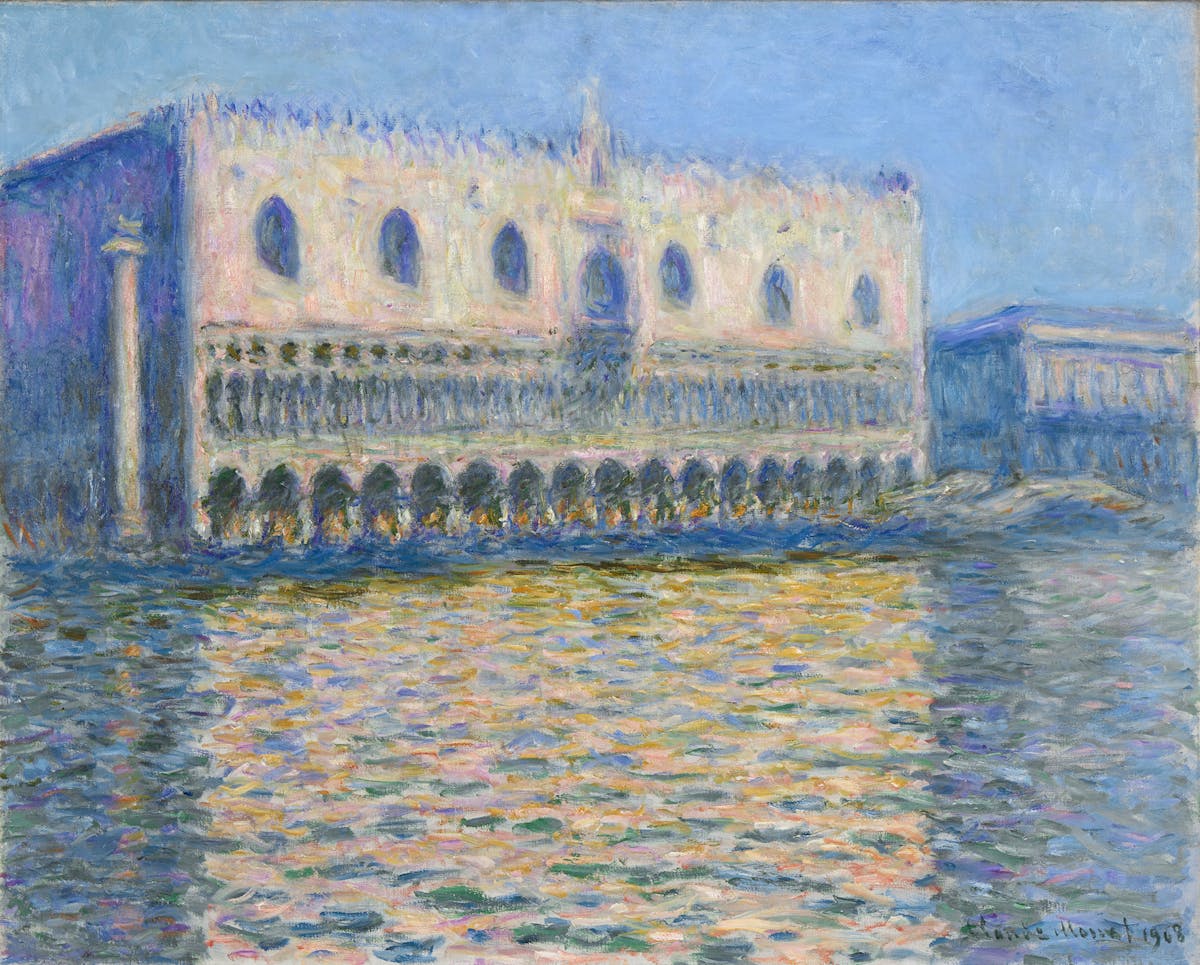At Long Last, an Exhibition of Their Own
Most startling of all the portraits is the ‘Young Woman of Albano’ by Corot, who summarizes his figure with broad, supple contours, and tellingly locates every detail within their gathering movements.

Monet to Morisot: The Real and Imagined in European Art
Brooklyn Museum
The Brooklyn Museum is one of the city’s largest and possesses some of the nation’s finest collections of Egyptian, African, and Oceanic art, but has always struggled in the shadows of its Manhattan counterparts. This has not been for lack of trying.
The “Sensation” exhibition of 1997 showed us the museum’s feisty side; the installation of Judy Chicago’s “Dinner Party” in 2007 testified to its ardent commitment to feminist art. More recently, the museum has engaged in local outreach programs and mounted exhibitions with populist themes.
Older museum-goers may remember a moderately sized but superb collection of European paintings permanently installed on the fifth floor. Here one could wander through near-empty galleries filled with the likes of Delacroix, Corot, Degas, and Matisse. Most of these paintings, however, have not been on view in decades, or have appeared only sporadically in “highlights of the collection” installations on the third floor.
The wait to see them again is over. “Monet to Morisot: The Real and Imagined in European Art” includes some 90 of these familiar works, sprinkled with a number by lesser-known artists such as the Russian Chana Orloff and the Hungarian Béla Kádár. Handsomely installed on pastel-colored walls, the work has been arranged in broad categories, such as “Near and Far” and “Performing Labor.” Such classifications can at times seem a bit arbitrary, but they provide a premise for an elegant, spacious ordering of the work.
A more insistent and underlying premise for the show enlivens the numerous wall texts. Time and again, we are reminded that every aspect of the artworks — the artists’ training, the paintings’ execution and subject matter, their purchase and exhibition — reflect the colonialist attitudes of privileged European males. This is a valid point: The selection of work includes none by people of color, and only a handful by women.
The heat and breadth of this argument may leave some visitors wondering: Are we to weep for these artists as victims, or curse them as collaborators? Should we de-link ourselves from this entire chain of exploitation, and head for the exit? It’s unlikely that the artists themselves would have desired any such reactions; they were self-evidently preoccupied with applying paint to canvas.
Indeed, any museum-goer who lingers in “Monet to Morisot” will find that these works speak very capably for themselves, in a particular visual language.
Greeting visitors to the show, the luscious brushstrokes of Monet’s “The Doge’s Palace” attest to his gift for exuberant, sunlit depths. With “mere” patches of color, he builds a visceral impression of a few intersecting elements: sun-splashed walls, deep space, and a canal that manages to be both a surface and a reflection.
Monet may not have been quite so adept at “classical” composing — the kind of proportionate detailing and rhythmic momentum of a painter like Claude Lorrain or Corot. (As Cézanne famously proclaimed, Monet was “…only an eye, but my God, what an eye!”) Here, however, Monet’s elemental design perfectly suits his attack.
Nearby hangs Fantin-Latour’s portrait of Madame Léon Maître, a tour de force of complex, atmospheric rendering. In this context, it feels like a more careful version of Monet’s light-induced attack. In a moment of brilliant curatorial wit, Fantin-Latour’s painting has been paired with Picasso’s muscular “Woman in Gray,” a dark painting similarly lightened by a woman’s bright, elaborate collar. What better foil for Fantin-Latour’s fine sensitivity than Picasso’s jackknifing, Cubist planes?
Hanging opposite these dueling personalities is Berthe Morisot’s double portrait of a mother and child. Here, the label helps; it discloses that the artist may have chosen such domestic subjects because respectable women were excluded from the evening entertainment venues frequented by men.
A subtle but exquisite colorist, Morisot moves with rich deliberation among various deep blues, mauves, and grays, which together set off the vivid lights of skin tones and fabric trim. One senses the artist’s empathy for her subjects, and how this was inseparable from her engagement with color and line. Their characters coalesce in step with the modeling of their forms. By comparison, Picasso’s painting seems just a little too reflexive, self-absorbed, and performative: too Picasso.
Most startling of all the portraits is the “Young Woman of Albano” by Corot, who summarizes his figure with broad, supple contours, and tellingly locates every detail within their gathering movements. Forms of arms, shoulders and neck build with steady purpose up to the complexity of the face, from which the eyes stare with the evenest of gazes. Corot’s brushwork can be feathery, his colors subdued, but here his rhythmic resolve lends unique intensity to the pose and expression.
Other notable paintings include Courbet’s moody portrait of a dark, turgid ocean, with a lone wave quivering barely above the viewer’s point of view. Pissarro’s complex landscape, depicting a path rising steeply on one side, with fields and houses peering between trees below, possesses a particular appeal: at once incisive in design, luminous in color, and modest in technique.
Two large paintings by Degas could be hardly more different from one another; his early, radiant painting of an exotic ballet production (the very first of his many depictions of these dancers) hangs next to an unfinished painting of a bather by a tub, all raw lines and bold tones. Familiar paintings by Bonnard, Cézanne, Boudin and Géricault grace various other walls.
The single greatest surprise is a cluster of small paintings, each one of them a gem, and all unknown to me. Were they always in storage? They include an Henri Rousseau self-portrait, posed with debonaire daftness next to a miniature bouquet; an abstraction by the French modernist Jean Hélion; and Matisse’s portrait of his model Lorette in a pink armchair — a simpler version of a painting that is one of highlights of the Met’s modern art holdings.
Most memorable of all is the pairing of two landscapes by Daubigny and Corot, each one an evocative panorama of trees and fields. From a distance, Daubigny’s sun-drenched landscape could be an especially radiant photograph. Up close, one finds it is all paint — multitudes of tiny, delicious brushstrokes.
In the Corot, one senses something else at work — a radically editing hand — as he attempts to shape a symphonic whole out of land, pond, sky, and the occasional house or figure. Patches of green slip above or below the hum of the horizon with contrapuntal vigor. A space opens over here to nest a tiny figure, and out there, to root the gleam of a far-away house.
Everything — whether a distant chimney or the spreading breadth of the groundplane — feels like it’s only just arrived, newly purposed, before our eyes. The painting is equally baffling and wondrous: in fact, both “real and imagined,” in the words of the exhibition’s subtitle.
Curiously absent from the show are two small Delacroix paintings that used to hang on the fifth floor. Also not present were some landscapes I knew particularly well, having copied them at the museum in the 1970s, brush and palette in hand. Remaking the energy of these paintings was a daunting but edifying experience. Unfortunately, in October 2020, the museum sold two of them: a robust Courbet and a subtle but vital Matisse. They are missed.
Of course, this only slightly detracts from the great regards of “Monet to Morisot,” which are available to anyone possessing the time and the interest — and, yes, $16. (Admission is free if you’re under 20).
February 11, 2022–May 21, 2023
(200 Eastern Parkway, Brooklyn, New York 11238, 718.638.5000
https://www.brooklynmuseum.org)

